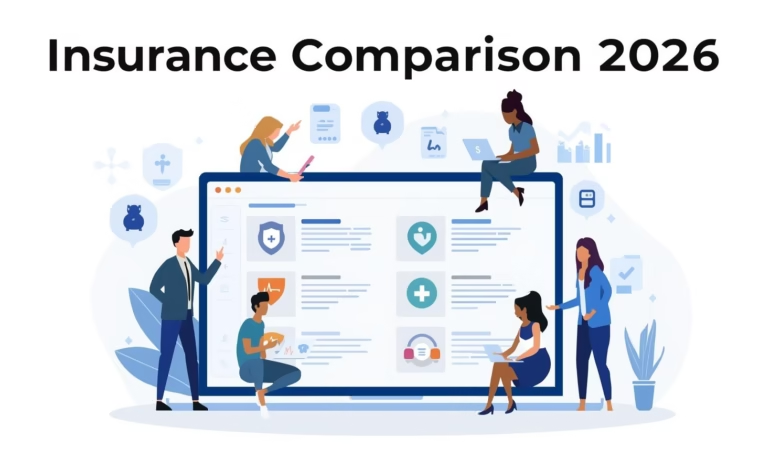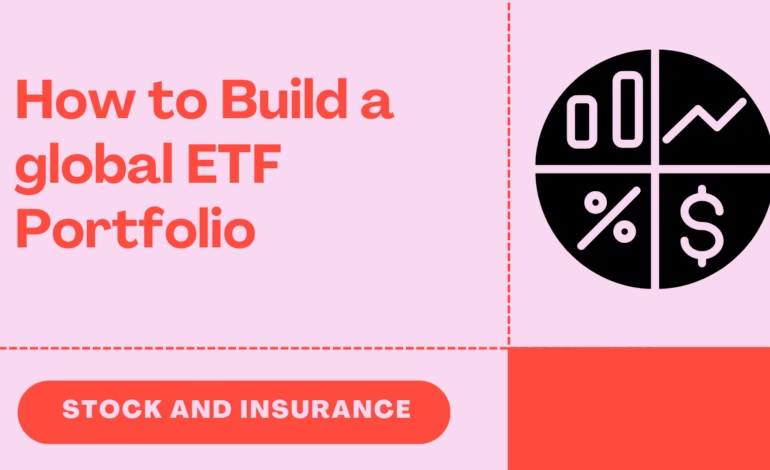
Understanding ETFs and Why Global Matters
When I first started investing, I remember opening my brokerage account and staring at dozens of tickers. I wanted exposure to the US market, but also to Europe, Asia, and even emerging markets. The problem? Buying individual stocks across regions is messy, expensive, and time-consuming. That’s where ETFs (Exchange-Traded Funds) entered my life.
If you’re reading this, you’re probably asking the same question: How to use ETFs to build a global portfolio without burning time and money? Good news, you’re in the right place.
ETFs are like investment baskets. Instead of buying one company, you buy a fund that holds many. A single ETF can give you exposure to hundreds or even thousands of companies worldwide. For example, the Vanguard Total World Stock ETF (VT) gives you instant access to more than 9,000 stocks across 40+ countries. That’s diversification in a click.
Why Global Exposure Is Not Optional Anymore
Think about it:
- The US is powerful, but 40 percent of global GDP comes from outside the US.
- Asia is the growth engine of the 21st century.
- Europe remains home to strong consumer and industrial brands.
Imagine only betting on one country’s future. What happens if that market underperforms? Investors who were solely focused on Japan in the 1980s learned this the hard way when the Nikkei index crashed and never returned to its peak for decades.
By spreading your investments globally using ETFs, you’re essentially buying insurance for your wealth’s future.
Quiz Time for You
Question: If you invested $10,000 only in US stocks in the early 2000s, would you have done better than someone who spread $10,000 across global markets?
Answer (from a hypothetical reader comment):
“I thought the US always wins, but actually global diversification outperformed during certain periods like the 2000s when US tech lagged.”
Exactly! No single market wins all the time. That’s why global exposure makes sense.
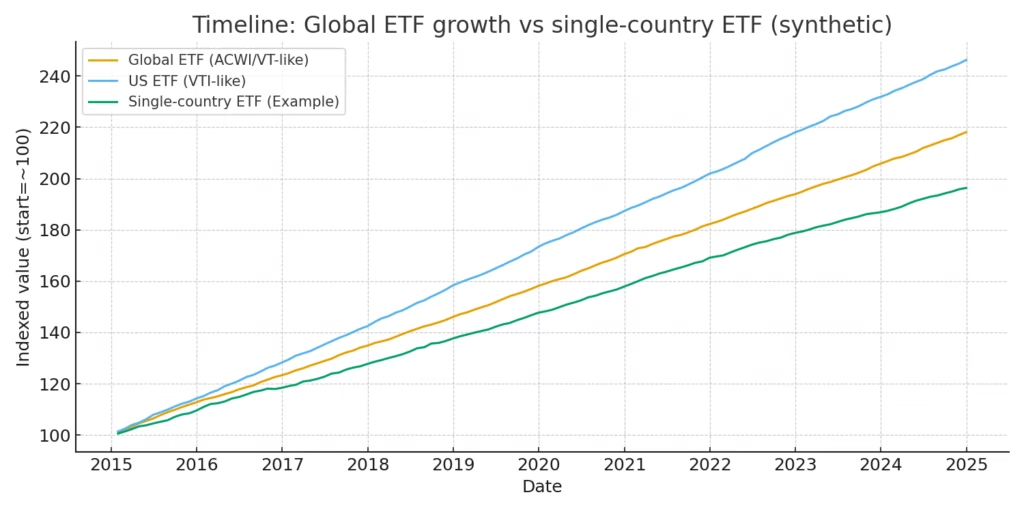
Types of ETFs for Global Investors
There are thousands of ETFs, but they fall into some clear categories:
- Global Market ETFs: Like VT (Vanguard Total World Stock ETF), giving exposure to all major markets.
- Regional ETFs: For example, iShares Europe ETF (IEV) or iShares Asia 50 ETF (AIA).
- Country-Specific ETFs: For instance, iShares MSCI Japan ETF (EWJ) for Japan, or iShares MSCI India ETF (INDA) for India.
- Sector-Based Global ETFs: Such as a global tech ETF like iShares Global Tech ETF (IXN).
Pro tip from experience: beginners often over-diversify by buying too many overlapping ETFs. If your “global portfolio” has 10 ETFs but 80 percent of them are weighted in US companies, you’re not really diversified.
Personal Experience: My First Global Portfolio
When I started, I put 70 percent into a US market ETF and sprinkled 30 percent into a Europe ETF. It looked great on paper, but after a year, I realized I was too heavy on developed markets and completely missing out on emerging markets like India and Brazil, which were booming.
That’s when I added Vanguard FTSE Emerging Markets ETF (VWO). Suddenly, my portfolio felt balanced, with exposure not only to the old powers but also to rising economies.
Internal & External Resource
- If you want a refresher on reading a company’s balance sheet, I wrote a detailed guide earlier.
- For global ETF basics, check out Vanguard’s official page on Vanguard Total World Stock ETF (VT).
Reader Question
Comment from Mark (US investor):
“So if I buy just one ETF like VT, is that enough to be considered global?”
My Response:
Yes, Mark. VT alone gives you exposure to thousands of companies worldwide. But some investors prefer adding specific country or sector ETFs to tilt towards certain growth opportunities. It depends on your risk appetite and goals.
Step-by-Step Guide to Building a Global Portfolio
So you understand the “why” behind global diversification. Now let’s build something real. Whether you are in the US, UK, Canada, Australia, or Singapore, the principles remain the same. The tools (ETFs) may differ slightly by market, but the strategy is universal.
Step 1: Define Your Investment Goal
Before buying your first ETF, pause. Ask:
- Am I building wealth for retirement?
- Am I saving for a house in 10 years?
- Am I simply experimenting with global investing?
Your time horizon matters. A young investor in their 20s can lean into growth-heavy ETFs (like emerging markets), while someone close to retirement may prefer a global mix with more stability (developed markets and bonds).
Step 2: Decide Your Asset Allocation
Here’s where the real fun begins. Asset allocation means deciding how much of your portfolio goes into stocks, bonds, and other assets.
For a global ETF portfolio, you’ll focus mainly on equities, but bonds and alternatives can also be added for balance.
Example allocations:
- Aggressive Investor (long horizon, high risk tolerance):
- 70% Global Equity ETFs (VT, VWO, IXN)
- 20% Regional Tilt ETFs (Europe, Asia, etc.)
- 10% Bonds (BNDX – Vanguard Total International Bond ETF)
- Balanced Investor:
- 50% Global Equity ETFs
- 20% Regional Tilt ETFs
- 20% Bonds
- 10% Alternatives (like REIT ETFs)
- Conservative Investor (retirement focus):
- 40% Global Equity ETFs
- 30% Bonds
- 20% Dividend-Focused ETFs
- 10% Cash-equivalents
Step 3: Pick Core Global ETFs
Think of your core ETFs as the foundation of your portfolio. These should be broad-based funds that cover thousands of companies.
- VT (Vanguard Total World Stock ETF): Covers developed + emerging markets.
- ACWI (iShares MSCI ACWI ETF): Another global ETF tracking all-country indexes.
- VTI (Vanguard Total Stock Market ETF) + VXUS (Vanguard Total International Stock ETF): Combo approach, splitting US vs international.
Pro tip: US investors often go with the VTI + VXUS mix to avoid overlaps and have more control over US vs non-US exposure.
Step 4: Add Satellite ETFs
Once your base is strong, you can tilt toward regions or themes.
Examples:
- IEV (iShares Europe ETF) – if you want European exposure.
- EWJ (iShares Japan ETF) – focused on Japan.
- INDA (iShares MSCI India ETF) – India’s booming economy.
- IXN (iShares Global Tech ETF) – global technology companies.
This is where personal conviction comes in. If you believe Asia will dominate the next decade, add more Asia-focused ETFs. If you’re bullish on green energy, add a clean-energy global ETF.
Step 5: Don’t Forget Bonds and Alternatives
Equity is sexy, but bonds are the stabilizers. If you’re building a truly global portfolio, you need global bond ETFs too.
Examples:
- BNDX – Vanguard Total International Bond ETF
- IGOV – iShares International Treasury Bond ETF
And if you want to diversify further, look at:
- VNQI – Vanguard Global ex-US Real Estate ETF (REITs)
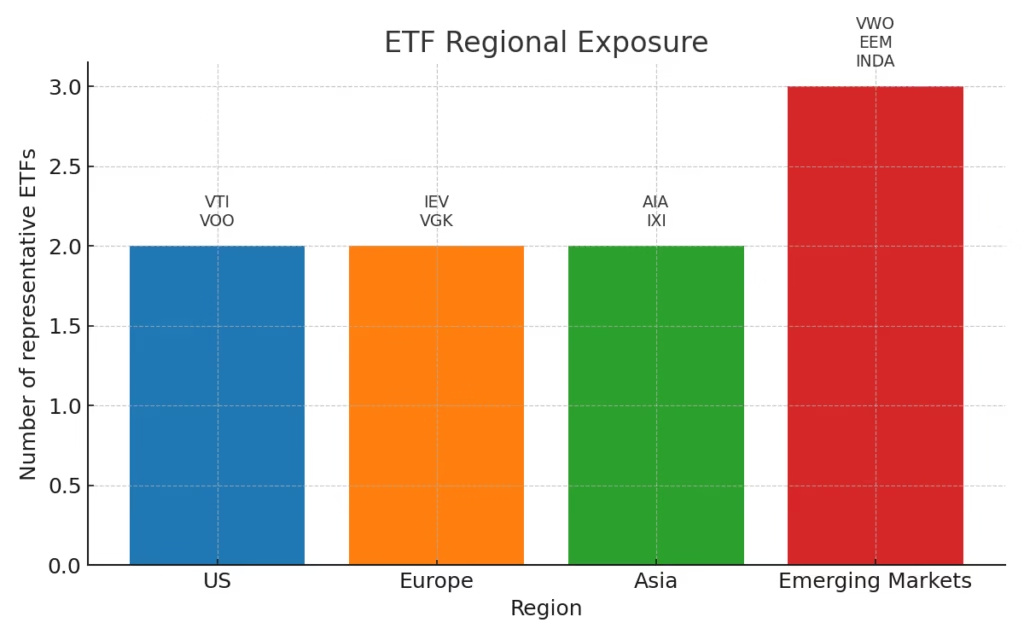
Real-Life Portfolio Example
Let’s say Sarah from Canada wants to build her portfolio with ETFs. She’s 30 years old, investing for retirement, and wants moderate risk.
Her portfolio could look like this:
- 50% VT (Total World ETF)
- 20% VWO (Emerging Markets ETF)
- 20% BNDX (Global Bonds ETF)
- 10% IXN (Global Tech ETF)
With just four ETFs, Sarah has exposure to thousands of stocks and bonds worldwide.
Quiz Time
Question: Which portfolio is more globally diversified?
- 70% S&P 500 ETF + 30% International ETF
- 100% Total World ETF (VT)
Comment (John from UK):
“I’d say option 1 because it has US + International separately.”
Response:
Nice try, John! But actually option 2 (VT) is broader because it covers developed and emerging markets directly, while option 1 might overweight the US heavily.
Step 6: Keep Costs in Mind
ETFs charge an expense ratio (management fee). Thankfully, most global ETFs are dirt cheap. For instance:
- VT expense ratio: 0.07%
- VXUS expense ratio: 0.07%
- ACWI expense ratio: 0.32%
Pay attention here. A difference of just 0.25% in fees can cost you tens of thousands of dollars over decades.
Step 7: Automate and Rebalance
Set up monthly contributions (SIPs for Indian readers, auto-invest plans for US/UK/Canada/Singapore/Australia readers). Every 6–12 months, rebalance. That means selling a little of what grew too much and adding to what fell behind.
Example: If emerging markets suddenly rally and go from 20% of your portfolio to 30%, trim them back to 20% and put the money into bonds or developed markets.
Comment from Priya (Singapore investor):
“How often should I rebalance my global ETF portfolio?”
My Response:
Once or twice a year is enough. Over-trading eats into returns. Stick to your allocation plan and let compounding do its magic.
Internal & External Resource
- You can read more on our Stock Analysis page where we break down individual ETF holdings.
- For a deeper look at ETF basics, check out Morningstar’s ETF guide.
Advanced Strategies, Mistakes, and Future-Proofing
By now, you know the basics of why global diversification matters and how to actually build a global ETF portfolio. In this final part, we’ll level up with advanced strategies, real-world case studies, and a look at where global ETFs are headed in the future.
Tax Considerations for Global ETFs
One area many beginners overlook is taxation. Taxes can eat into your returns if you don’t plan carefully.
- Dividend Withholding Tax: Many countries withhold taxes on dividends before they reach you. For example, US ETFs may withhold 30% on dividends for non-US investors unless tax treaties apply.
- Capital Gains Tax: Selling ETFs for a profit might trigger capital gains. This varies by country US, UK, Canada, Australia, and Singapore all have different rules.
- ETF Domicile Matters: Some investors in Europe prefer UCITS ETFs (domiciled in Ireland or Luxembourg) because they are tax-efficient and widely accepted across the EU.
Pro Tip: Check if your country has a double taxation treaty with the US. If it does, you might reclaim part of those dividend taxes.
Common Mistakes Investors Make
- Overlapping ETFs
Buying VT + VXUS + VWO often doubles your exposure because VT already includes VXUS and VWO. Too much overlap means wasted fees. - Chasing Performance
Don’t overweight a region just because it’s trending. In the 2010s, emerging markets looked like the future, but they underperformed US stocks for almost a decade. - Ignoring Currency Risk
A UK investor buying US ETFs is exposed to dollar-pound fluctuations. Sometimes it helps, sometimes it hurts. Many ETFs now offer “currency-hedged” versions. - Not Rebalancing
Even the best allocation drifts over time. Without rebalancing, your portfolio can become riskier than you intended.
Case Study: Two Investors, Two Outcomes
Investor A – The Overconfident Local
Tom, based in the US, invests only in the S&P 500 (SPY ETF). For 10 years, he does great, but then a decade comes when the US underperforms global markets. His portfolio stagnates while others grow.
Investor B – The Patient Global Builder
Emma, based in Australia, invests in VT and adds a 20% tilt to Asia ETFs. Over the same period, she rides both US growth and Asia’s emerging power. Her portfolio grows steadily, with less volatility.
Moral? Global beats local over the long haul.
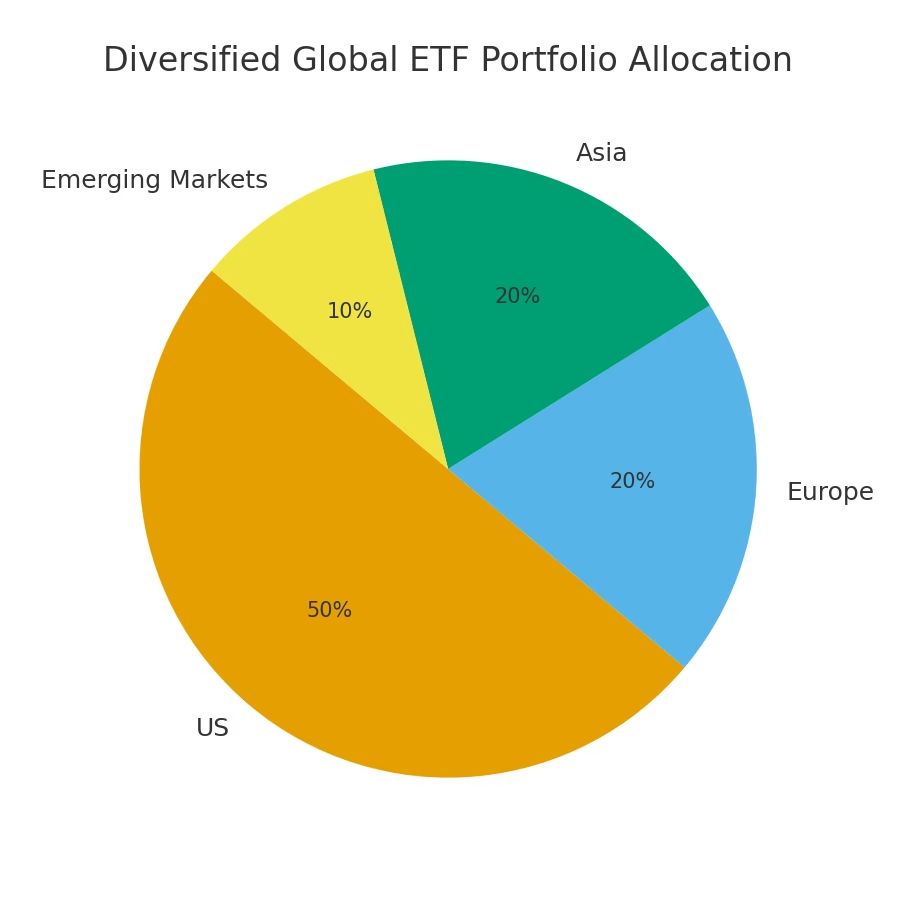
Quiz Time
Question: Which is riskier? owning 100% US stocks or owning a basket of US + Europe + Asia + Emerging Markets?
Comment (Alex from Canada):
“The global basket seems safer because it spreads risk.”
Response:
Correct, Alex. The global basket reduces “home bias” risk. No matter where you live, betting only on your home country’s stock market is like putting all your eggs in one basket.
Future of Global Investing with ETFs
The ETF industry is evolving fast, and global investors have more tools than ever:
- Thematic Global ETFs: Want exposure to renewable energy, AI, or space exploration worldwide? There are ETFs for that.
- Bond + Equity Hybrid ETFs: Some funds now package stocks and bonds together for instant balance.
- Fractional ETF Investing: Many brokers in the US, UK, and Australia now allow fractional ETF purchases, so you can buy with as little as $5.
- ETF Innovation in Asia: Singapore and Hong Kong are growing hubs for ETF trading, making global access easier for Asian investors.
My Personal Advanced Strategy
Once I had my core global portfolio in place, I started experimenting with satellite tilts:
- Added Global Clean Energy ETF (ICLN) to capture renewable energy trends.
- Added Global Healthcare ETF (IXJ) for long-term demographic plays.
- Reduced exposure to slow-growth regions when needed.
The result? My core stays steady while satellites let me ride trends without too much risk.
Comment from Sarah (UK):
“What if I want to retire in 15 years? Should I still keep a global ETF-heavy portfolio?”
My Response:
Good question, Sarah. In your case, a mix of global equities and bonds makes sense. Keep the growth exposure but gradually increase global bond ETFs to reduce volatility as retirement approaches.
Internal & External Resource
- Explore our Wealth Building Guide for practical steps on compounding.
- For detailed tax-efficient ETF investing, see Bogleheads Wiki on Non-US Investors.
Wrapping It All Up
Let’s bring this together.
- ETFs are the best tool for building a global portfolio because they’re cheap, diversified, and accessible.
- A strong core ETF (like VT or ACWI) gives you instant worldwide exposure.
- Add satellite ETFs for regions or sectors you believe in.
- Stay aware of taxes, fees, and currency risks.
- Rebalance regularly and avoid chasing short-term fads.
With this three-part roadmap, you’re not just asking how to use ETFs to build a global portfolio you’re living it.
The beauty of global investing is that it removes the burden of guessing “which country wins next.” Instead, you own the whole world, letting compounding and global growth work for you.
Final Takeaway
If you’re sitting on the fence, start small. Buy one global ETF. Watch it. Learn from it. Add slowly. Over time, you’ll see your portfolio not just grow but also weather storms better than single-market investors.
Remember, the world is big and so should your portfolio be.

